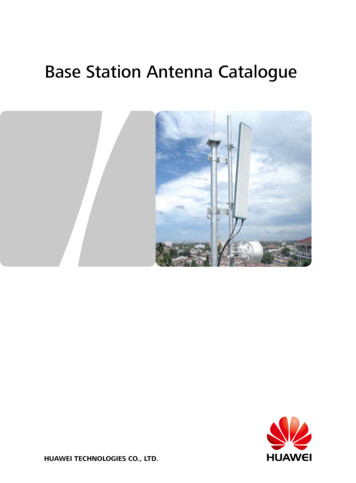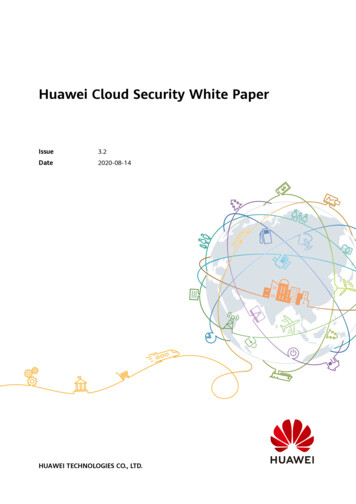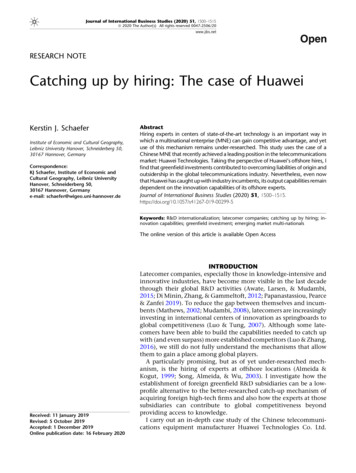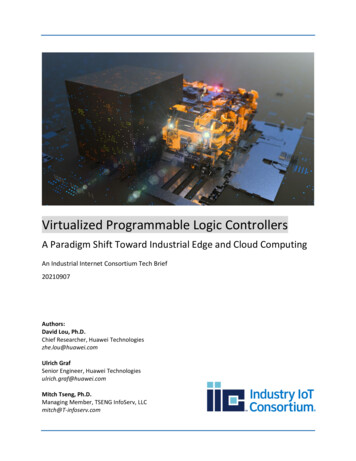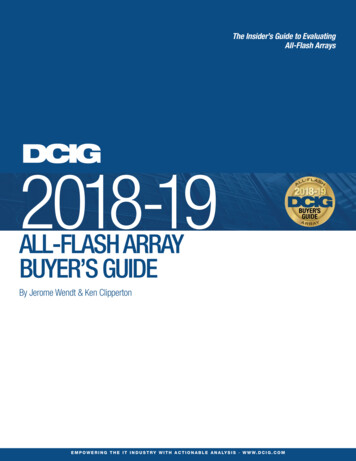
Transcription
The Insider’s Guide to EvaluatingAll-Flash Arrays2018-19ALL-FLASH ARRAYBUYER’S GUIDEBy Jerome Wendt & Ken ClippertonE M P O W E R I N G T H E I T I N D U S T R Y W I T H A C T I O N A B L E A N A LY S I S · W W W. D C I G . C O M
2018-19 ALL-FLASH ARRAY BUYER’S GUIDEThe Insider’s Guide to Evaluating All-Flash ArraysTable of Contents1Introduction3Executive Summary5How to Use this Buyer’s Guide5Disclosures6Inclusion Criteria6The Eight-Step Process Usedto Rank the Products7DCIG Thoughts and Comments on 7789101012121313All-Flash Array 4445464748495051525354Compression and DeduplicationBreadth of VMware vSphere API SupportNon-volatile Memory Express InterfaceScale-up versus Scale-out AFA ArchitecturesCapacity, Density, and Power ConsumptionPredictive AnalyticsNon-disruptive Upgrades (NDU)Performance and PricingBest PracticesDCIG Observations13161922Recommended RankingExcellent RankingAll-Flash Array RankingsDell EMC Unity 550F All-FlashDell EMC Unity 650F All-FlashDell EMC VMAX 250FX AFADell EMC VMAX 450FX AFAHitachi Vantara VSP F400Hitachi Vantara VSP F600Hitachi Vantara VSP F800Hitachi Vantara VSP F1500HPE 3PAR StoreServ 9450HPE 3PAR StoreServ 20450HPE Nimble Storage AF5000 All Flash ArrayHPE Nimble Storage AF7000 All Flash ArrayHPE Nimble Storage AF9000 All Flash ArrayHuawei OceanStor 5300F V5Huawei OceanStor 5500F V5Huawei OceanStor 5600F V5Huawei OceanStor 5800F V5Huawei OceanStor 6800F V5Huawei OceanStor Dorado5000 V3 (NVMe)Huawei OceanStor Dorado5000 V3 (SAS)Huawei OceanStor Dorado6000 V3NetApp AFF A200NetApp AFF A300Pure Storage FlashArray//M10Pure Storage FlashArray//M20Pure Storage FlashArray//M50Pure Storage FlashArray//M70Pure Storage FlashArray//X70Tegile HD2040 SeriesTegile HD2080 SeriesTegile N5200Tegile N5800AppendicesA-1 Appendix A—Definitions, Explanations and TerminologyB-1 Appendix B—Vendor Contact InformationC-1 Appendix C—DCIG Contact InformationLicensed to Huawei with unlimited and unrestricted distribution rights through May 31, 2019. 2018 DCIG, LLC. All rights reserved.i
2018-19 ALL-FLASH ARRAY BUYER’S GUIDEThe Insider’s Guide to Evaluating All-Flash ArraysIntroductionAny organization that has yet to adopt an all-flash storage infrastructure for all activeworkloads is operating at a competitive disadvantage.All-flash storage helps organizations move faster makes existing applications run faster even as data sets grow accelerates application development enables IT departments to say, “Yes” to new workloads andthen get those new workloads producing results in record time drives down data center operating costsDCIG is pleased to present this fresh snapshot of the dynamic all-flash array (AFA) marketplace.Much has changed in the all-flash array marketplace since DCIG published the DCIG 2017-18All-Flash Array Buyer’s Guide. Some of the more significant changes are summarized below.Marketplace consolidation continues. As expected, some AFA providers were acquiredby other storage companies. HPE acquired Nimble Storage. Western Digital acquired Tegile.Technologies that increase performance proliferate. These performance-enhancing technologies include new multicore CPUs from Intel, faster Fibre Channel and Ethernet networkingports, and NVMe SSDs. Thus, more processing capability is being matched up with morebandwidth between application hosts and storage controllers, and between storage controllers and flash memory drives.Dramatic increase is flash capacity. The raw capacity of the more than 100 all-flash arraysDCIG researched averaged 4.4PB, a 5x increase compared to the products in the 2017-18edition. The highest capacity product can provide 70 petabytes (PB) of all-flash capacity, a 7xincrease.Unified storage is now the AFA norm. The first generations of all-flash arrays were nearlyall block-only SAN arrays. Tegile was perhaps the only truly unified AFA provider. Today, morethan 80% of the arrays in this Buyer’s Guide support unified storage; as do more than half ofall AFA’s DCIG researched.Most AFA’s now integrate with cloud storage. More than half of the products in thisBuyer’s Guide can use public cloud storage as a target for cold data or for snapshots as partof a data protection mechanism. In many cases this target is actually one of the provider’sown arrays running in a cloud data center or a software-defined storage instance of its storage system running in one of the true public clouds.Predictive analytics get real. Some storage providers can document how predictive storage analytics is enabling increased availability, reliability, and performance for their products.The promise is huge. Progress varies.Performance claims are included on most of the data sheets. In a break from ourstandard practice, this Buyer’s Guide includes performance claims for IOPS, bandwidthand average latencies on the data sheets. These claims may hint at underlying architecturalefficiencies or may have no connection with real world results. All performance claims areprovided by the vendor, published by the vendor, and/or available from third parties that havetested the products. DCIG has not independently substantiated or verified these claims.Licensed to Huawei with unlimited and unrestricted distribution rights through May 31, 2019. 2018 DCIG, LLC. All rights reserved.1
2018-19 ALL-FLASH ARRAY BUYER’S GUIDEThe Insider’s Guide to Evaluating All-Flash ArraysIntroduction(continued)The Value This DCIG Buyer’s Guide Creates for BuyersThe DCIG 2018-19 All-Flash Array Buyer’s Guide helps businesses accelerate the all-flasharray selection process. This Buyer’s Guide includes data sheets for thirty-two (32) enterpriseclass all-flash arrays that achieved rankings of Recommended or Excellent. These productscome from seven (7) vendors including Dell EMC, Hitachi Vantara, HPE, Huawei, NetApp,Pure Storage and Tegile.As in the development of all prior DCIG Buyer’s Guides, DCIG’s analysts have alreadydone the heavy lifting for enterprise technology buyers by: Identifying a common technology need with many competing solutionsbut with little comparative data available to technology purchasers Scanning the environment to identify available products in the marketplace Gathering normalized data about the features each product supports Providing an objective, third-party evaluation of those features froman end-user perspective Describing key product considerations and important changes in the marketplace Presenting DCIG’s opinions and product feature data in a way that facilitates rapidfeature-based comparisonsThe end result is that the DCIG 2018-19 All-Flash Array Buyer’s Guide drives time and costout of the product selection process by enabling prospective buyers to more quickly identifya shortlist of products that meet their specific needs. Thus, prospective purchasers can focustheir product evaluation energies and move more quickly to the competitive bid process.Note that this Buyer’s Guide is not intended to be a substitute for bringing individual productsin-house for testing nor should readers assume that DCIG does any hands-on testing ofthese products. Many end user license agreements associated with these products prohibitthe publishing of testing results without first getting vendor approval. In-house testing orproof-of-concept implementations should still be done, if possible, since each product willperform differently under different application workloads and data center environments. Wehope you find that this Buyer’s Guide meets its intended purpose in your environment.Jerome and KenLicensed to Huawei with unlimited and unrestricted distribution rights through May 31, 2019. 2018 DCIG, LLC. All rights reserved.2
2018-19 ALL-FLASH ARRAY BUYER’S GUIDEThe Insider’s Guide to Evaluating All-Flash ArraysExecutiveSummaryEnterprises are accelerating their adoption of flash memory SSDs in workstations, serversand shared storage arrays. Flash memory offers significant performance benefits and operational efficiencies when compared to hard disk drives (HDDs). The continued price erosionof NAND also contributes to enterprises using flash memory in ever greater amounts. Thishas led IDC to forecast that worldwide SSD shipments will increase at a five-year compoundannual growth rate of 15.1% though 2021.1Many now recognize that while flash in its current incarnation is much faster than hard diskdrives (HDDs), flash has the potential to increase performance another 10x as providers andenterprises identify and eliminate outdated disk-oriented constructs.To deliver on this next generation of flash performance, enterprises will need to makechanges up and down today’s data center stack. Enterprises must: Evaluate the storage network interconnects between servers and storage arrays.Enterprise data centers still largely rely upon FC and iSCSI as the preferred storageprotocols to connect servers and storage arrays. But as applications optimize for flash andstorage arrays offer new interfaces that better deliver on the performance characteristicsof flash, existing FC and iSCSI storage protocols will eventually become choke points.While the demise of these protocols is not imminent, new protocols such as NVMe-oFhave already emerged while existing protocols such as InfiniBand are getting a new look. Account for ever higher capacity SSDs. As this Buyer’s Guide goes to press, 15TBSSDs ship on some all-flash arrays, Samsung and Toshiba have announced 30TB SSDs,and we have seen previews of 50TB and even 100TB SSDs. To capitalize on the capacitythese SSDs can provide, enterprises will need to verify that any all-flash array using themoffers the appropriate backend connectivity such as NVMe. While NVMe technology isstill in its early stages, about 20 percent of the all-flash arrays that DCIG evaluatedalready support NVMe as a backend connection to SSDs. Examine and optimize applications for non-volatile memory. Many applicationsinclude specific code to account for the latencies associated with traditional storage.Most all-flash arrays deliver latencies that are 10x lower than traditional arrays, andNVMe may enable another 10x reduction. To take full advantage of this performancepotential, application owners must rewrite and remove code that accounts for thelatencies of HDDs while creating new code that better leverages and optimizes for thelow-latency and parallelism of NVMe-connected flash and storage-class memoriessuch as 3D XPoint. Insist on predictive analytics capabilities. Enterprises are virtualizing (or containerizing)and consolidating many workloads onto high-performance application servers andall-flash arrays. It is not feasible for any human being to know how all these workloads willinteract with one another or how to distribute and configure these applications to ensurethe highest levels of availability, reliability, and performance at the lowest cost. Therefore,enterprises should consider predictive analytics capabilities a prerequisite for any all-flasharray that will provide storage for multiple applications and workloads.1. IDC Forecasts Strong Growth for the Solid State Drive (SSD) Industry as IT Transitions to 3D NAND Flash.”, IDC Press Release,IDC, 20 Dec. 2017, www.idc.com/getdoc.jsp?containerId prUS43390217.Licensed to Huawei with unlimited and unrestricted distribution rights through May 31, 2019. 2018 DCIG, LLC. All rights reserved.3
2018-19 ALL-FLASH ARRAY BUYER’S GUIDEThe Insider’s Guide to Evaluating All-Flash ArraysExecutive Summary(continued)Executive SummaryThrough DCIG’s evaluation of hundreds of features supported by each product, and(continued)comparing them to what features enterprises most need, DCIG can make recommendationsas to which appliances are best positioned for enterprise use.It is in this context that DCIG presents the DCIG 2018-19 All-Flash Array Buyer’s Guide. Asprior DCIG Buyer’s Guides have done, it puts at the fingertips of enterprises a resource thatcan assist them in this important buying decisionThe DCIG 2018-19 All-Flash Array Buyer’s Guide accomplishes the following objectives: Provides an objective, third-party evaluation of products that evaluates and ranks theirfeatures from an end user’s viewpoint Includes recommendations on how to best use this Buyer’s Guide and the productscontained in it Evaluates the features of each product based upon criteria that matter most so end userscan quickly know which appliance is most appropriate for them Provides a standardized data sheet for each product so end users can do quickcomparisons of the features supported and not supported on each product Gives any organization the ability to request competitive bids from different providersLicensed to Huawei with unlimited and unrestricted distribution rights through May 31, 2019. 2018 DCIG, LLC. All rights reserved.4
2018-19 ALL-FLASH ARRAY BUYER’S GUIDEThe Insider’s Guide to Evaluating All-Flash ArraysHow to Use this Buyer’s GuideThis Buyer’s Guide is intended to help users accelerate theirproduct research and selection process—driving cost outof the research process while simultaneously increasingconfidence in the results. The purpose of this Buyer’s Guideis NOT intended to tell users exactly which product(s) topurchase. Rather, it is to guide them in coming up with a listof competitive products that have comparable features thatmeet their specific needs.Features, as displayed on each product data sheet, represent the opinion of DCIG. DCIG encourages and stronglyrecommends every organization verify the functionality of thefeatures that are of interest to them before making a buyingdecision. To help in that decision, this Buyer’s Guide givesorganizations a sense of how products compare with eachother, as well as giving additional insight into what otherproduct offerings are available on the market and the specificfeatures they offer.DCIG recommends that companies use this Buyer’s Guide inthe following seven ways:1. Eliminate the painstaking research normally associated with identifying a shortlist of products that meettheir needs. This Buyer’s Guide evaluates 32 productsfrom 7 providers. Each product is ranked Recommendedor Excellent based on standard deviation ranges. Morethan 100 different features were evaluated, so organizations only need to look at the rankings and features tocome up with a shortlist for consideration.2. Do apples-to-apples comparisons of products fromdifferent vendors. It behooves organizations to getcompetitive bids from multiple vendors. But that tacticonly works well when organizations know that they arereceiving competitive bids on products that are roughlycomparable. Using this Buyer’s Guide, organizations cando a better job of accomplishing that objective.3. Separate the apples from the oranges. Just asimportant as doing apples-to-apples comparisonsis identifying when an orange is thrown into the mix.Sometimes it is difficult for an organization to know ifit is truly getting a good deal when bids come in fromvendors that include different products. Now organizations can refer to the rankings and features of eachproduct in this Guide so they can determine if they aregetting comparable products.4. Gain perspective on how products from less well-knownvendors compare against established and betterknown brands. There’s a built-in level of comfort whenbuying products from well-known vendors. There’s also abuilt-in resistance to buying products from vendors that areperceived as unknown quantities. This Buyer’s Guide helpsto remove some of that apprehension about buyingproducts from lesser known vendors. Using this Buyer’sGuide, organizations can see how these products stack up.5. Normalize complex terminology. Every industry has aproclivity to create acronyms and jargon that is specific to it.This Buyer’s Guide sifts through the acronyms and jargonand then normalizes these terms, providing a foundation formeaningful comparisons. Definitions for these normalizedterms are provided in the Glossary at the end of this Guide.6. Take advantage of standardized data sheets toquickly compare products side-by-side. Product datasheets that vendors make available are rarely laid out inthe same way or contain the same information. Somevendors even have data sheet formats that vary fromproduct to product within their own portfolio. This Buyer’sGuide tackles this problem by creating a standard,easy-to-read data sheet for every product. In this way,product data sheets for individual products can bereferenced and the features on them quickly compared.7. Help justify buying recommendations to businessteams. An overall product ranking is included at the topof every product data sheet. This overall rankingsummarizes in a single word how feature rich a productis compared to other products in the Buyer’s Guide.DisclosuresOver the last few years the general trend in the United Stateshas been for both large and boutique analyst firms to receivesome or all their revenue from vendors.DCIG is no different in this respect as it also receivespayment for some assets it produces. The services thatDCIG provides include blogging, battle cards, customervalidations, executive white papers, pocket analyst reports,white papers and special reports.In the interest of transparency, some vendors included inthis DCIG Buyer’s Guide are or have been DCIG clients.This is not to imply that their products were given preferential treatment in the Buyer’s Guide.Licensed to Huawei with unlimited and unrestricted distribution rights through May 31, 2019. 2018 DCIG, LLC. All rights reserved.5
2018-19 ALL-FLASH ARRAY BUYER’S GUIDEThe Insider’s Guide to Evaluating All-Flash ArraysIn that vein, there are some important facts to keep in mindwhen considering the information contained in this Buyer’sGuide and its merit. No vendor paid DCIG any fee to research this topicor arrive at predetermined conclusions DCIG did not guarantee any vendor that its productwould be included in this Buyer’s Guide DCIG did not imply or guarantee that a specific productwould receive a preferential ranking in this Buyer’s Guide,before or after completion of research All research was based upon publicly available information, information provided by the vendor, and/or theexpertise of those evaluating the information No negative inferences should be drawn against anyvendor or product not covered in this Buyer’s Guide It is a misuse of this Buyer’s Guide to compare productsincluded in it against products not includedBecause of the number of features analyzed, there was noway for DCIG to accurately predict at the outset how individualproducts would end up ranking. DCIG wants to emphasizethat no vendor was privy to how DCIG weighed individualfeatures. In every case the vendor only found out the rankingsof its product(s) after the analysis was complete.Inclusion CriteriaThe DCIG 2018-19 All-flash Array Buyer’s Guide wasderived from DCIG’s All-flash Array Body of Research thatexamined more than 100 products. The following criteriawere used when determining whether to include a specificproduct in this Buyer’s Guide: Product is available in an all-flash configuration Product supports at least two controllers Sufficient information available to reachmeaningful conclusions Product must be formally announced and/or generallyavailable for purchase as of March 1, 2018 Product achieved a ranking of Recommended or ExcellentUltimately, it is the professional judgment of the analystsworking on each DCIG Buyer’s Guide whether a productmeets the inclusion criteria.The Eight-Step Process Usedto Rank the ProductsTo rank each product included in this Buyer’s Guide, DCIGwent through an eight-step process to come to the mostobjective conclusion possible.1. DCIG established which features would be evaluatedand which ones would not. Prior to selecting thefeatures which would be evaluated, DCIG quantified,then “normalized” the list of available features such thata common name for e
Pure Storage FlashArray//M10 47 Pure Storage FlashArray//M20 48 Pure Storage FlashArray//M50 49 Pure Storage FlashArray//M70 50 Pure Storage FlashArray//X70 51 Tegile HD2040 Series 52 Tegile HD2080 Series 53 Tegile N5200 54 Tegile N5800 icensed to uawei with unlimited and unrestricted distriution rights through May 31 2019. 2018 DCIG, LLC.
